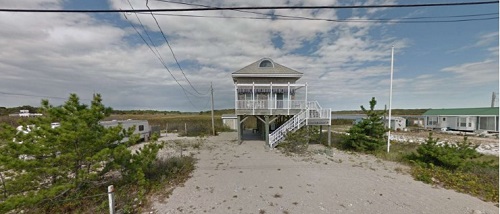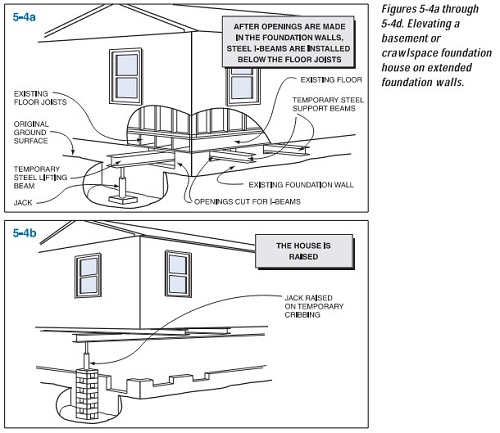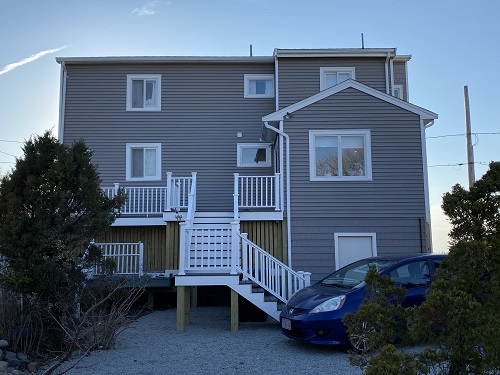Photo by Home Owner
Architects and engineers are addressing issues due to increasingly severe coastal storms and projected sea level rise. Approaches include constructing barriers, improved and extended sea walls, and modifying infrastructure designs to move key equipment higher in the building and providing for lower level space that can withstand flooding.

Coastal Home, South Coast Massachusetts (Google Street View)
When you drive (or in my case, bike) along the coast in Massachusetts, you’ll come across several houses that are being retrofit to make them more resilient. Houses are being raised several feet, basement space is no longer used, and in some cases the structures are raised on piers. I spoke with a friend who lives on the coast south of Boston who had her home raised, and she shared some thoughts about the experience:
ENR: When did you first think about raising your house?
I had been thinking about it for at least 10 years and seriously for two years before making the decision to do it. The trigger event was the flood of January, 2018 and the subsequent bad storms we had that winter.
ENR: How did you go about finding an architect/contractor to help with the work? Did you find a lot of experienced people available to help you?
I first turned to the contractor that I've used over the years to do improvements to the house - rebuilding a porch, remodeling the kitchen, redoing the roof - etc. The company has always done a great job at a fair price. They begin the work when they promise - work steadily (unless waiting for a surprisingly delayed sub) - and finish on or nearly on-time. I tried to get other estimates, but didn't find a contractor who was able/willing to do the complete job. I thought, and still think, that it's important to find a "full-service" team to do the work. There are so many tasks that are sequential, or interlocking or interrelating that a piecemeal construction plan or an independent multi-party construction team would be a scheduling nightmare.
ENR: How was it decided how high to lift your house?
Great question! I tried all sorts of ways, including:
1. Looking at the FEMA and Union of Concerned Scientists' studies (which give sets of possible ranges of likely sea level rise in various scenarios) and
2. Talking to local builders, my survey engineer, other people who had raised their homes.
I couldn't find any really clear guidance. I worked with the median UCS range of estimates and then tried to factor in storm surges (estimating values based on what we had previously experienced and then making them higher to add a factor of safety). Remember, you are raising the house to protect from both future sea level rise and storm surges - neither of which are subject to specific predictions at this point. So in that sense, it is difficult to find specific guidance because available information is, at best, an estimate. Fortunately the house is not next to the ocean and it is set a bit back from the bay. So we didn't need to take into account direct wave action as much in the estimate.
All along I talked about it with my family, my Love, and other people I respect to get their feedback and views. We settled on a raise high enough to avoid floor water on the first floor for at least 30 years (at which point the house will be ready for a re-do anyway, based on future conditions and technology) and not so high that access to it (with all the extra stairs) would be uncomfortable/daunting.
So, I made what I felt was an informed decision based on as much information as I could get, in consultation with others who had gone through a similar process.
ENR: Can you describe the general process that you and the contractor used to do the work?
In the general sequence:
- Consult with your local Conservation Commission about your permitting requirements and process; you'll probably need their approval and Orders of Condition before you start any work
- You'll probably need a certificate of elevation to an Existing and Proposed site plan, and to fill out a form requesting Orders of Condition from your local Conservation Commission. They may need to make a pre-construction site inspection, too
- Shut off gas and water (my job) and work with electric company on continued service (both contractor and me)

Photo by Home Owner
- Prepare the site for the machinery and bring in the beams for lifting
- Cut holes in the foundation for the lifting beams

Photo by Home Owner
- Take out duct work from forced hot air system - removed (to be replaced with baseboard hydronic electric)
- Lift the house - jacks and beams lift it in a day - they gave special attention to my fireplace and flues, which lifted up with the house - We had it inspected after lifting and were told that the flues were intact and brick chimney structurally sound.
- Pour new footings and install understory piers supporting the center beam
- Pour new foundation on top of existing
- Set house down on sills
- Attach house to sills with metal straps - from understory - all around

From FEMA Homeowner’s Guide to Retrofitting, Chapter 5
- Cut holes for and install smart vents
- Cut new hole in basement cement floor to allow tidal in- and out-flow
- Fill to outside grade with sandy mix and gravel.
- Install new door for "understory" (I no longer want to call it a basement, because we don't use it for storage)
- Run water, electric, gas service
- Spray in insulation on the underside of first floor

Photo by Home Owner
- Reconstruct decks to new elevation
- Complete internal adjustments - closet where stairs to basement used to be, new heating, etc.
- Wait till spring to check to make sure all windows opened and closed (just two windows are slightly wedged)
- Patch any cracks - there were only three small ones!
ENR: What did you need to do to prepare your house prior to it being raised?
As the owner, I had to work with the gas company and water company to shut off their utilities. The gas company can take quite a while to coordinate! Also, work with electric company to continue electrical service.
I also removed pictures from walls and breakables from shelves. This turned out to be totally unnecessary!
ENR: Did you need to temporarily move out during the work, for how long?
Yes! We rented a house for three months, which is how long the contractor said the job would take to make it livable. We moved back in after 4 months. (There were workmen, dust and dirt, etc. making our return later than expected.)
ENR: Were you satisfied with the outcome, and can you share any lessons learned?
Yes. I'm satisfied with the outcome. During the job, it was a mess! It was complicated and a hassle! It was expensive!! But I feel much more secure and that the house is secured from damage.
Some lessons:
#1. Work with a general contractor who can/will handle and coordinate all or almost all of the tasks (This is what we did and I think it made all the difference!)
#2. Stay on top of the progress (or lack of) and make sure the contractor keeps your job a priority
#3. Make sure your contractor consults with you about materials to be used.
Most importantly, I hope readers are fortunate enough to have a love, spouse (which can also be a love), or close family members or friends who can be a constant consultant - someone who knows you, will listen to you, understands and shares your goals, and will help you through the many decisions and turning points during the process of planning and construction.
House raising may become more common and routine in the near future. You get the sense in the above discussion and in research that there are not yet clear guidelines for how much to raise a structure. But information and approaches for how to do it has been available for awhile. The methods have mostly been used for moving houses and structures to new sites, as opposed to raising them in place.
It is interesting that insurance looks to play an increasing role. The insurance process helps to provide incentive to improve coastal infrastructure resiliency. But another challenge is consideration of areas where it may too expensive to provide insurance.
It is one approach to retrofit coastal infrastructure to improve resiliency. Risks in living by the coast and in low-lying areas can reduced with help from AE designers and constructors.

Job complete- Photo by Home Owner


Post a comment to this article
Report Abusive Comment